Abstract
Recent clinical and experimental evidence suggests that the fetus responds to injury in a fashion fundamentally different from that of the adult. Our initial experience with human open fetal surgery reinforces experimental observations that the fetal wounds heal without the scarring, inflammation, and contraction that often accompany adult wounds. In this study we examine fetal wound fluid in an attempt to elucidate the control mechanisms that endow the fetus with unique healing properties. The extracellular matrix of fetal wounds is rich in hyaluronic acid, a glycosaminoglycan found in high concentrations whenever there is tissue proliferation, regeneration, and repair. We establish that wound fluid from the fetus contains high levels of hyaluronic acid-stimulating activity that may underlie the elevated deposition of hyaluronic acid in the fetal wound matrix. In contrast there was no hyaluronic acid-stimulating activity present in adult wound fluid. Hyaluronic acid, in turn, fosters an extracellular environment permissive for cell motility and proliferation that may account for the unique properties observed in fetal wound healing.
Full text
PDF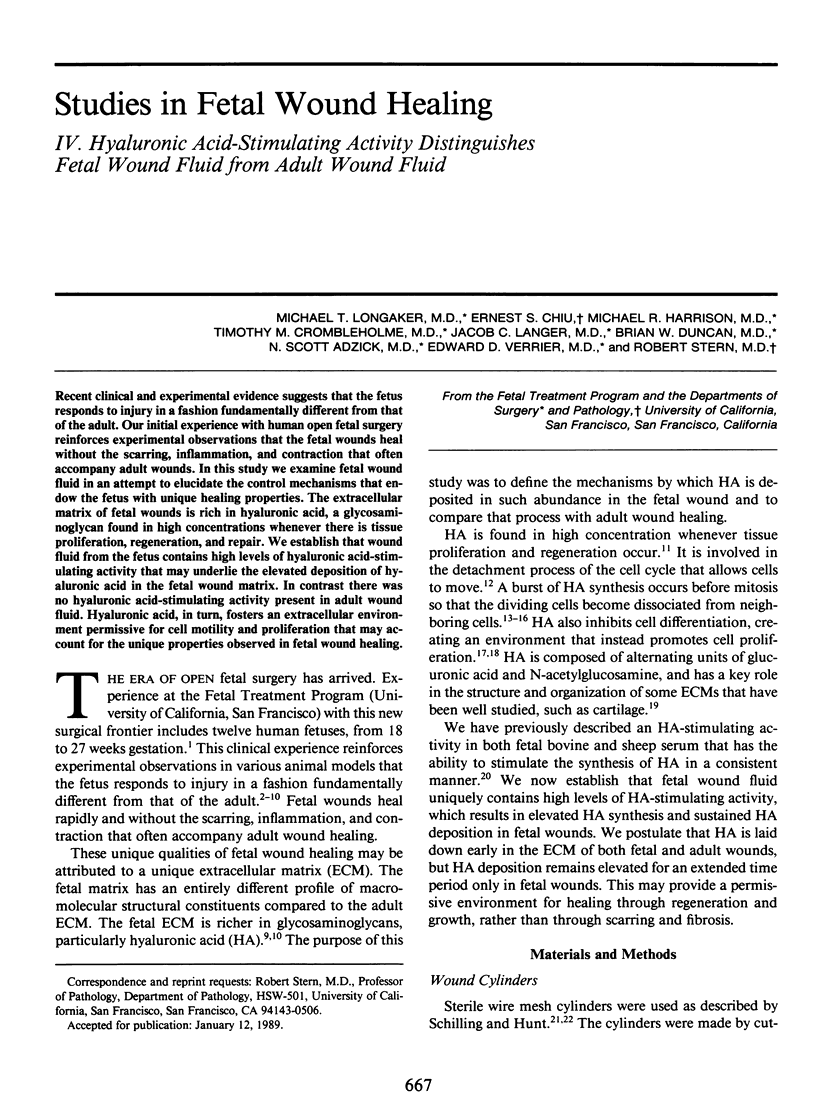
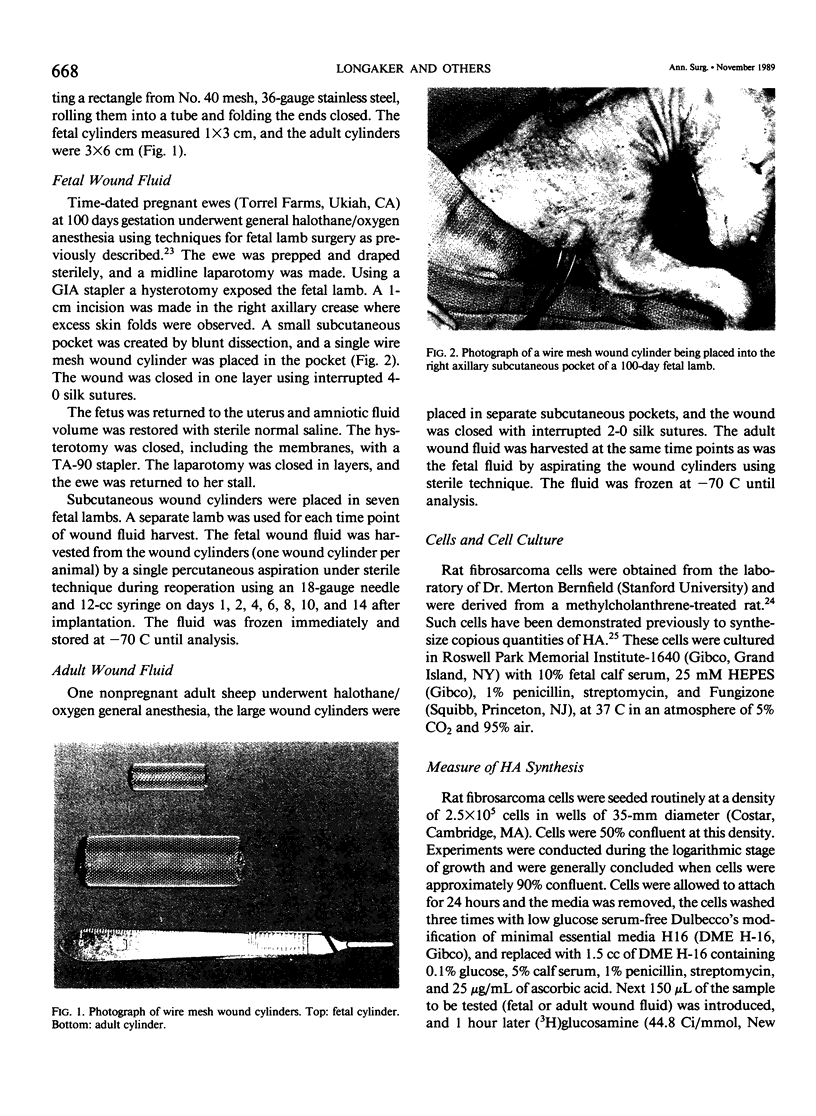
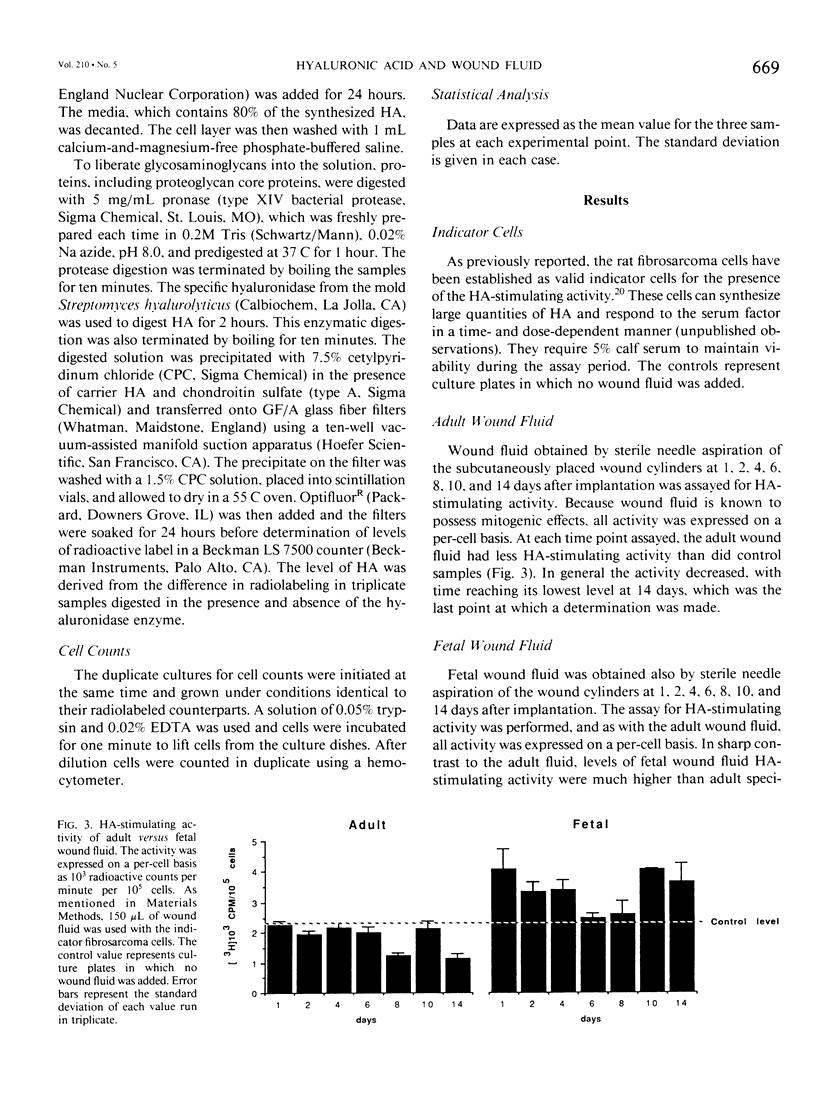
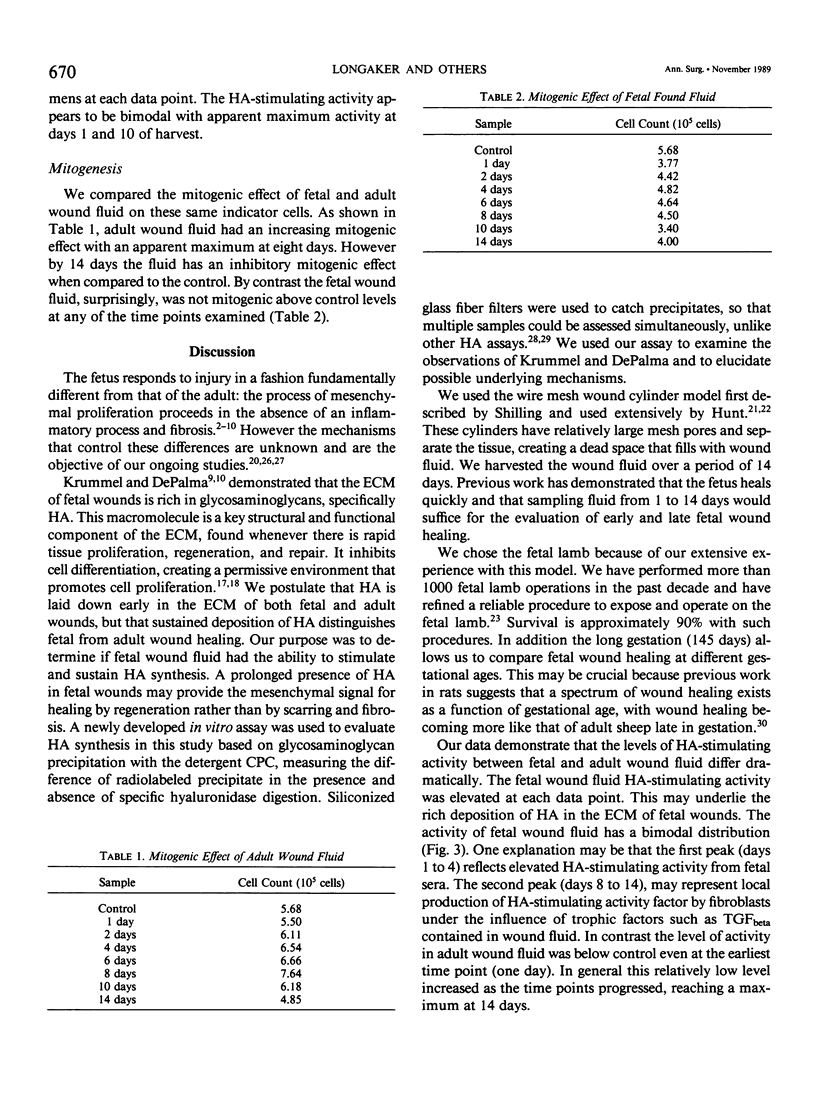
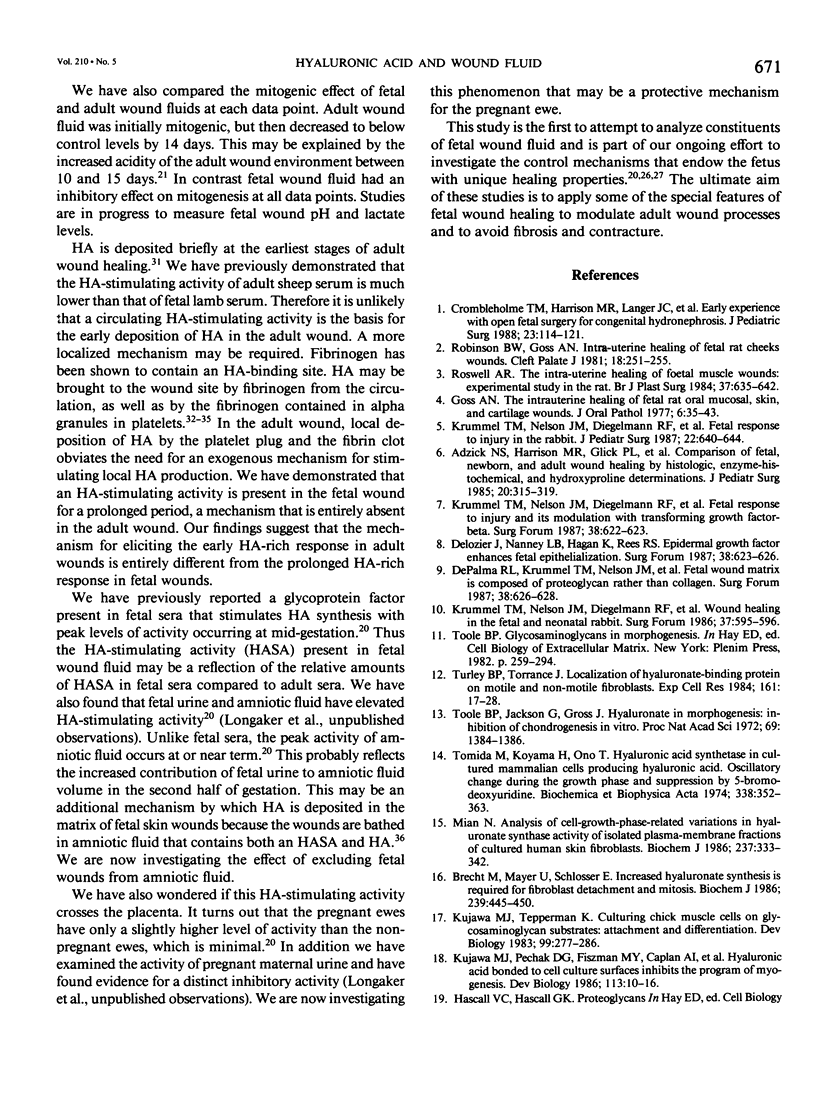
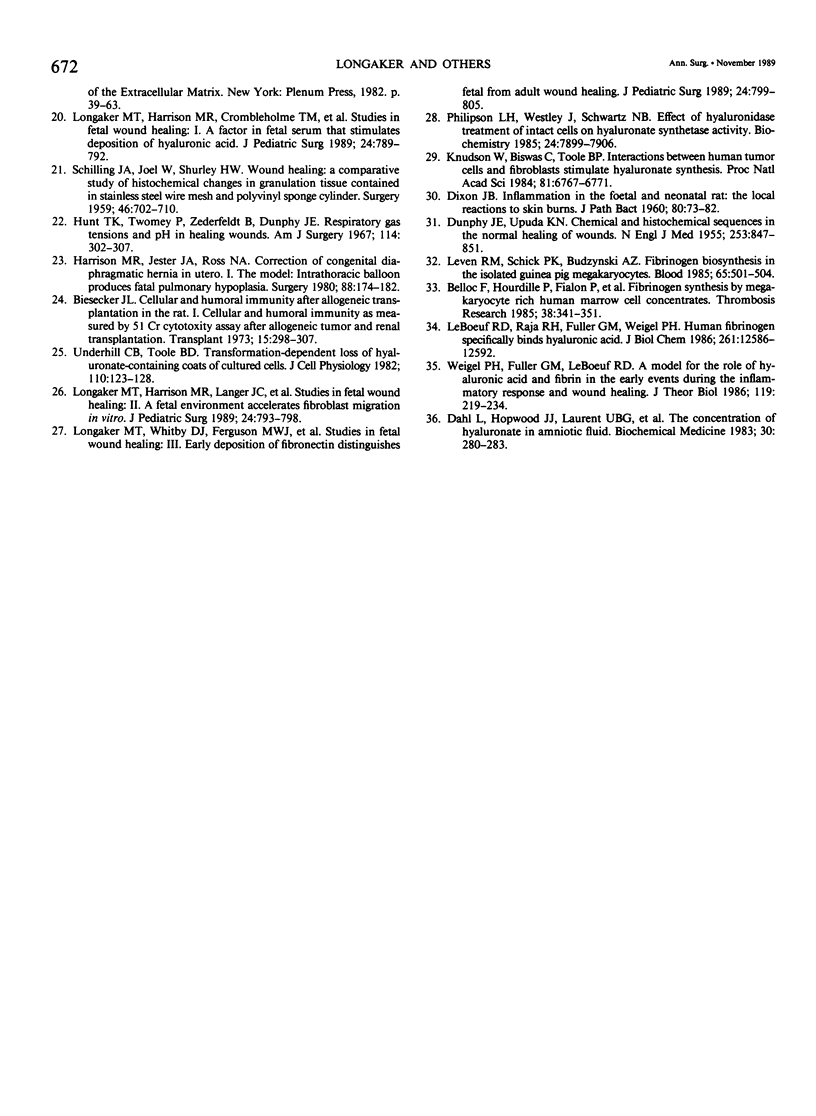
Images in this article
Selected References
These references are in PubMed. This may not be the complete list of references from this article.
- Adzick N. S., Harrison M. R., Glick P. L., Beckstead J. H., Villa R. L., Scheuenstuhl H., Goodson W. H., 3rd Comparison of fetal, newborn, and adult wound healing by histologic, enzyme-histochemical, and hydroxyproline determinations. J Pediatr Surg. 1985 Aug;20(4):315–319. doi: 10.1016/s0022-3468(85)80210-4. [DOI] [PubMed] [Google Scholar]
- Belloc F., Hourdille P., Fialon P., Boisseau M. R., Soria J. Fibrinogen synthesis by megakaryocyte rich human marrow cell concentrates. Thromb Res. 1985 May 15;38(4):341–351. doi: 10.1016/0049-3848(85)90133-1. [DOI] [PubMed] [Google Scholar]
- Biesecker J. L. Cellular and humoral immunity after allogeneic transplantation in the rat. I. Cellular and humoral immunity of measured by a 51 Cr cytotoxicity assay after allogeneic tumor and renal transplantation. Transplantation. 1973 Mar;15(3):298–307. doi: 10.1097/00007890-197303000-00006. [DOI] [PubMed] [Google Scholar]
- Brecht M., Mayer U., Schlosser E., Prehm P. Increased hyaluronate synthesis is required for fibroblast detachment and mitosis. Biochem J. 1986 Oct 15;239(2):445–450. doi: 10.1042/bj2390445. [DOI] [PMC free article] [PubMed] [Google Scholar]
- DIXON J. B. Inflammation in the foetal and neonatal rat: the local reactions to skin burns. J Pathol Bacteriol. 1960 Jul;80:73–82. doi: 10.1002/path.1700800109. [DOI] [PubMed] [Google Scholar]
- DUNPHY J. E., UDUPA K. N. Chemical and histochemical sequences in the normal healing of wounds. N Engl J Med. 1955 Nov 17;253(20):847–851. doi: 10.1056/NEJM195511172532002. [DOI] [PubMed] [Google Scholar]
- Dahl L., Hopwood J. J., Laurent U. B., Lilja K., Tengblad A. The concentration of hyaluronate in amniotic fluid. Biochem Med. 1983 Dec;30(3):280–283. doi: 10.1016/0006-2944(83)90018-2. [DOI] [PubMed] [Google Scholar]
- Goss A. N. Intra-uterine healing of fetal rat oral mucosal, skin and cartilage wounds. J Oral Pathol. 1977 Jan;6(1):35–43. doi: 10.1111/j.1600-0714.1977.tb01792.x. [DOI] [PubMed] [Google Scholar]
- Harrison M. R., Jester J. A., Ross N. A. Correction of congenital diaphragmatic hernia in utero. I. The model: intrathoracic balloon produces fatal pulmonary hypoplasia. Surgery. 1980 Jul;88(1):174–182. [PubMed] [Google Scholar]
- Hunt T. K., Twomey P., Zederfeldt B., Dunphy J. E. Respiratory gas tensions and pH in healing wounds. Am J Surg. 1967 Aug;114(2):302–307. doi: 10.1016/0002-9610(67)90388-1. [DOI] [PubMed] [Google Scholar]
- Knudson W., Biswas C., Toole B. P. Interactions between human tumor cells and fibroblasts stimulate hyaluronate synthesis. Proc Natl Acad Sci U S A. 1984 Nov;81(21):6767–6771. doi: 10.1073/pnas.81.21.6767. [DOI] [PMC free article] [PubMed] [Google Scholar]
- Krummel T. M., Nelson J. M., Diegelmann R. F., Lindblad W. J., Salzberg A. M., Greenfield L. J., Cohen I. K. Fetal response to injury in the rabbit. J Pediatr Surg. 1987 Jul;22(7):640–644. doi: 10.1016/s0022-3468(87)80117-3. [DOI] [PubMed] [Google Scholar]
- Kujawa M. J., Pechak D. G., Fiszman M. Y., Caplan A. I. Hyaluronic acid bonded to cell culture surfaces inhibits the program of myogenesis. Dev Biol. 1986 Jan;113(1):10–16. doi: 10.1016/0012-1606(86)90103-x. [DOI] [PubMed] [Google Scholar]
- Kujawa M. J., Tepperman K. Culturing chick muscle cells on glycosaminoglycan substrates: attachment and differentiation. Dev Biol. 1983 Oct;99(2):277–286. doi: 10.1016/0012-1606(83)90277-4. [DOI] [PubMed] [Google Scholar]
- LeBoeuf R. D., Raja R. H., Fuller G. M., Weigel P. H. Human fibrinogen specifically binds hyaluronic acid. J Biol Chem. 1986 Sep 25;261(27):12586–12592. [PubMed] [Google Scholar]
- Leven R. M., Schick P. K., Budzynski A. Z. Fibrinogen biosynthesis in isolated guinea pig megakaryocytes. Blood. 1985 Feb;65(2):501–504. [PubMed] [Google Scholar]
- Longaker M. T., Harrison M. R., Crombleholme T. M., Langer J. C., Decker M., Verrier E. D., Spendlove R., Stern R. Studies in fetal wound healing: I. A factor in fetal serum that stimulates deposition of hyaluronic acid. J Pediatr Surg. 1989 Aug;24(8):789–792. doi: 10.1016/s0022-3468(89)80538-x. [DOI] [PubMed] [Google Scholar]
- Longaker M. T., Harrison M. R., Langer J. C., Crombleholme T. M., Verrier E. D., Spendlove R., Stern R. Studies in fetal wound healing: II. A fetal environment accelerates fibroblast migration in vitro. J Pediatr Surg. 1989 Aug;24(8):793–798. doi: 10.1016/s0022-3468(89)80539-1. [DOI] [PubMed] [Google Scholar]
- Longaker M. T., Whitby D. J., Ferguson M. W., Harrison M. R., Crombleholme T. M., Langer J. C., Cochrum K. C., Verrier E. D., Stern R. Studies in fetal wound healing: III. Early deposition of fibronectin distinguishes fetal from adult wound healing. J Pediatr Surg. 1989 Aug;24(8):799–805. doi: 10.1016/s0022-3468(89)80540-8. [DOI] [PubMed] [Google Scholar]
- Mian N. Analysis of cell-growth-phase-related variations in hyaluronate synthase activity of isolated plasma-membrane fractions of cultured human skin fibroblasts. Biochem J. 1986 Jul 15;237(2):333–342. doi: 10.1042/bj2370333. [DOI] [PMC free article] [PubMed] [Google Scholar]
- Philipson L. H., Westley J., Schwartz N. B. Effect of hyaluronidase treatment of intact cells on hyaluronate synthetase activity. Biochemistry. 1985 Dec 31;24(27):7899–7906. doi: 10.1021/bi00348a008. [DOI] [PubMed] [Google Scholar]
- Robinson B. W., Goss A. N. Intra-uterine healing of fetal rat cheek wounds. Cleft Palate J. 1981 Oct;18(4):251–255. [PubMed] [Google Scholar]
- Rowsell A. R. The intra-uterine healing of foetal muscle wounds: experimental study in the rat. Br J Plast Surg. 1984 Oct;37(4):635–642. doi: 10.1016/0007-1226(84)90166-8. [DOI] [PubMed] [Google Scholar]
- SCHILLING J. A., JOEL W., SHURLEY H. M. Wound healing: a comparative study of the histochemical changes in granulation tissue contained in stainless steel wire mesh and polyvinyl sponge cylinders. Surgery. 1959 Oct;46:702–710. [PubMed] [Google Scholar]
- Toole B. P., Jackson G., Gross J. Hyaluronate in morphogenesis: inhibition of chondrogenesis in vitro. Proc Natl Acad Sci U S A. 1972 Jun;69(6):1384–1386. doi: 10.1073/pnas.69.6.1384. [DOI] [PMC free article] [PubMed] [Google Scholar]
- Turley E. A., Torrance J. Localization of hyaluronate and hyaluronate-binding protein on motile and non-motile fibroblasts. Exp Cell Res. 1985 Nov;161(1):17–28. doi: 10.1016/0014-4827(85)90486-0. [DOI] [PubMed] [Google Scholar]
- Underhill C. B., Toole B. P. Transformation-dependent loss of the hyaluronate-containing coats of cultured cells. J Cell Physiol. 1982 Feb;110(2):123–128. doi: 10.1002/jcp.1041100204. [DOI] [PubMed] [Google Scholar]
- Weigel P. H., Fuller G. M., LeBoeuf R. D. A model for the role of hyaluronic acid and fibrin in the early events during the inflammatory response and wound healing. J Theor Biol. 1986 Mar 21;119(2):219–234. doi: 10.1016/s0022-5193(86)80076-5. [DOI] [PubMed] [Google Scholar]




